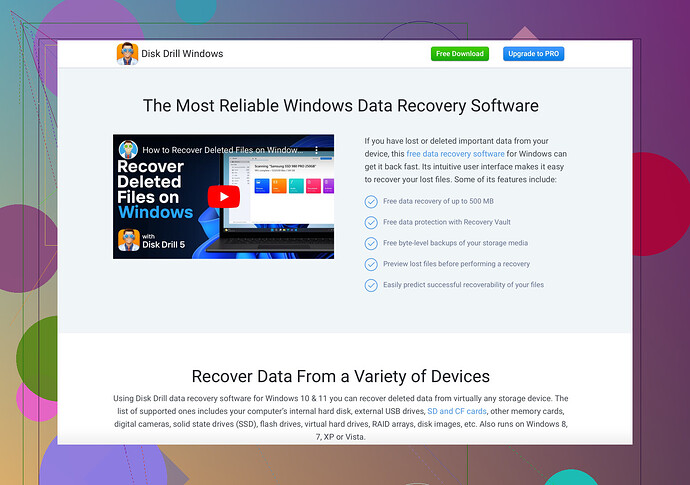I accidentally deleted some important files off my Lexar SD card. These files are really crucial for my project. Does anyone know how I can recover them? Any reliable software or methods would be greatly appreciated.
Oh, man, that’s a bummer! Been there, done that. Here’s the lowdown on getting your files back.
First off, try to stop using the SD card ASAP to prevent overwriting the deleted files. This is crucial!
You’re in luck because there are some solid software options out there for this exact issue. For instance, Disk Drill Data Recovery Software is pretty reliable. It’s user-friendly and works well for SD cards, recovering various file types. Just download it, run a scan on your Lexar SD card, and it’ll list the recoverable files. You can preview and select which files you want to recover. Pretty neat, right?
Another good practice is to check if your SD card has any sort of backup or if the files were synced automatically to a cloud service. It might save you the hassle of using recovery software.
If you wanna try another route, Recuva is another popular choice and sometimes works when others don’t. It’s free and easy to use; just don’t expect miracles if the card’s been heavily written over since the deletion.
Best advice: always back up crucial files in the future. But for now, these tools should help you get back what you lost.
Hey, just chiming in on this data recovery situation!
I get it, losing important files can be super stressful. Aside from what @espritlibre suggested, another software you might want to look into is PhotoRec. It’s open-source, which means it’s free and pretty good at recovering files from various formats of memory cards, including SD cards. The user interface isn’t the prettiest, but it gets the job done. Here’s how you can use it:
- Download and install PhotoRec.
- Insert your Lexar SD card into your computer.
- Run PhotoRec and select your SD card.
- Follow the prompts to scan and recover files.
One key thing to point out is that, unlike Disk Drill or Recuva, PhotoRec will often recover a lot of files, including some you might not need, so be prepared to sift through them.
If you’re into more technical tools and you’re comfortable with using command lines, TestDisk is another powerful option for data recovery, especially if the partitions on your SD card are messed up.
As a less technical tip, check if the files might be in the Recycle Bin if you deleted them through your computer. It’s a simple step but can sometimes save you.
And just a quick word of advice, try to make it a habit to back up your important files regularly. There are tons of cloud storage options out there like Google Drive or Dropbox which can be lifesavers in these scenarios.
Lastly, here’s a quick shoutout to Disk Drill. It’s quite efficient and user-friendly, making it a solid choice for SD card data recovery.
Hope this helps and you get your project files back without too much hassle!
Alright, listen up. First off, don’t fret; it happens to the best of us. Here are some alternative routes to getting your files back without retreading the same suggestions.
Use a Recovery Software that stands out
EaseUS Data Recovery Wizard - Known for its robust file recovery abilities and user-friendly interface. Compared to Disk Drill, EaseUS offers a wizard where even tech-noobs can perform recoveries with confidence.
Pros:
- Beginner-friendly
- Fast scans
- Multiple file types
Cons:
- Free version has limited recovery
Device Check
External Devices - Sometimes, your data might still be cached in devices where you initially used the SD card. Plug your Lexar SD card back into that device and give it a thorough search. Magical recoveries do happen.
Professional Help
Data Recovery Services - If you’re hitting a wall with DIY methods, it might be time to visit a professional data recovery service. Yes, it costs more, but they have specialized tools and expertise to retrieve those crucial files.
Pros:
- Higher recovery rate
- Handles severely damaged cards
Cons:
- Expensive
- Time-consuming
Preventive Measures
Next time, use a version-control system like Git. It’s not just for coding; it’s great for tracking and reverting changes to any file types. Or invest in a solid backup strategy using cloud services like Google Drive or Dropbox.
Analyzing Disk Drill
Disk Drill - Undeniably top-notch. A detailed analysis shows it’s reliable with a high recovery success rate.
Pros:
- Multiple file types recovery
- Sleek design
- Preview function before recovery
Cons:
- Free version limitations
Competitors’ Recap
Recuva - Great, but over-recovery can be annoying.
PhotoRec - Effective, albeit less user-friendly.
Ultimate tip: Consider setting up file-syncing software. Tools like Syncthing keep your files synced automatically across devices, minimizing data loss risks.
Go through these steps, consider your options, and let’s get those files back where they belong!
